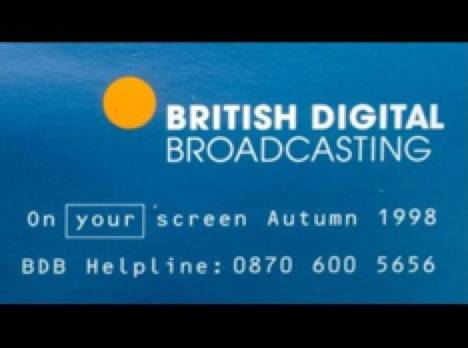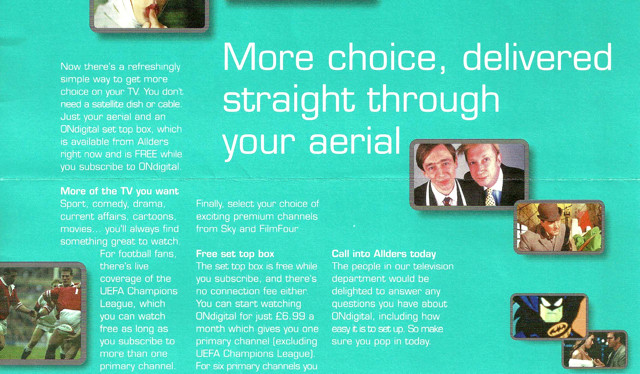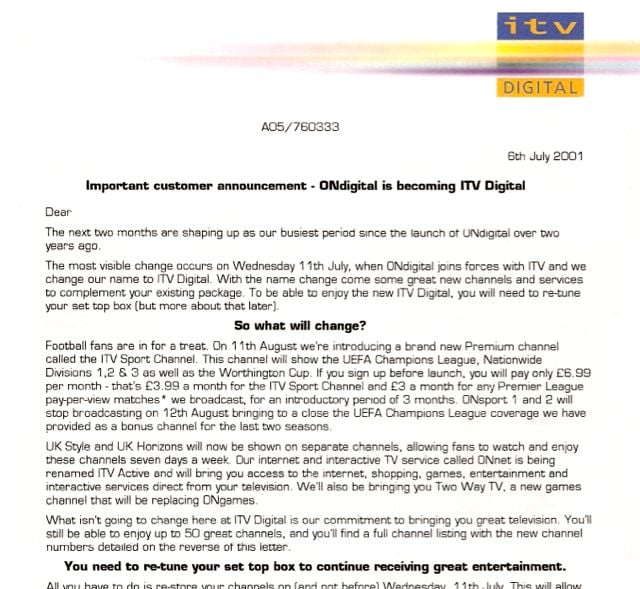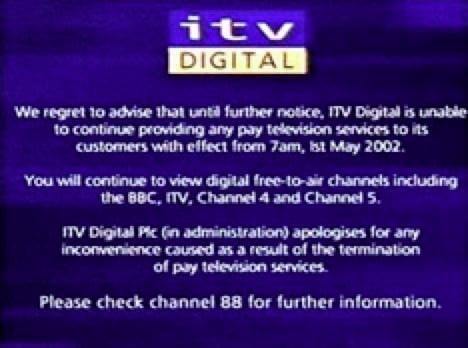Original URL: https://www.theregister.com/2012/11/15/archaeologic_uk_digital_terrestrial_tv_is_14_years_old/
UK digital terrestrial TV turns 14 today
Freeview may be ten years old, but there's a gawky teenager peering over its shoulder
Posted in Legal, 15th November 2012 11:14 GMT
Archaeologic is an occasional column focus on retro tech and digital archaeology. Today, a look back at the events that went into motion 14 years ago and led to the foundation of the bedrock of UK TV, Freeview.
Freeview, Britain’s free-to-air terrestrial digital TV brand, is ten years old. It formally launched at the end of October 2002, so you might wonder why it’s being covered now, several weeks late. It’s because the platform’s story goes back a further four years, to November 1998 and the debut of ONdigital.
In the mid-1990s, six frequency bands, called multiplexes, were assigned for digital broadcasting. In December 1997, three of the six were bid for and won by British Digital Broadcasting (BDB), a company founded by Rupert Murdoch’s BSkyB and the holders of two major regional ITV franchises, Carlton and Granada. BDB went to market as ONdigital, a brand first made public in July 1998.
ONdigital began transmitting four months later, on 15 November 1998. It initially offered 18 premium channels for a regular monthly subscription, along with digital version of all the major free-to-air channels. ONdigital immediately began ploughing through a £90 million marketing budged to promote the service to the 70 per cent of the population it calculated were then able to receive it.
Unfortunately, BSkyB had already scooped it, launching its own digital service, Sky Digital, more than a month before. BSkyB had been forced out of BDB back in 1997 because of competition concerns. Not only that, b but it was told it must make key channels such as Sky Movies and Sky Sports available to BDB. Naturally, it was not happy.
So it competed aggressively. Sky’s offering comprised not only 200 channels but its upfront cost was 80 per cent cheaper than of the price of ONdigital: £159 to the £199 BDB wanted for its set-top boxes, made by Pace, Philips and, later, Nokia. Sky executives also claimed fewer than 45 per cent of Brits would be able to pick up Ondigital, a far lower figure than BDB had stated.
Punters may not have cared much, in any case. Back then, Brits seemed satisfied with a pair of BBC channels, whatever broadcasters was running ITV in their region - though by this point many of the regional franchise holders had been acquired by Carlton or Granada, who themselves would later merge - and Channel 4. Digital video was a novelty - the DVD format had only just been launched and most folk were still on VHS - and Sky had only carved its a place for its satellite service by spending big on sports and films.
Sky’s analogue service launched in November 1990 and, from October 1998, it began using its Sports and Movies channels to encourage analogue subscribers to upgrade to digital.
ONdigital struggled to compete. Giving away boxes and a later attempt to bundle the a year’s subscription into the up-front cost of the box, helped push up subscriber numbers, though the schemes smacked of desperation. The pre-pay plan was launched on 1 November 1999, by which point ONdigital had more than 247,000 subscribers. Sky was shortly claiming more than 900,000, though that included folk with analogue hardware. By the end of the year, though, ONdigital was up to 542,000.
Fine, but ONdigital had already said it wouldn’t break even until it had at least 2 million subscribers, a point it expected to reach in 2002. It hoped to hit 1 million during 2000, but that milestone wasn’t reached until the very end of the year. A bigger problem was the number of households signing up for a while and then dropping out. Through the service’s life, the best part of 25 per cent of its customer base was not renewing subscriptions. So Ondigital had to persuade that many folk to sign up, just to maintain its subscriber count, let alone increase it.
TV times
In a bid to give the operation new vigour, Carlton and Granada relaunched ONdigital as ITV Digital in July 2001. The mix of the well-known ITV brand - which they didn’t own; it was applied to all the independent broadcasters, not all of them at that point owned by Carlton or Granada - and the overbid acquisition of what used to be called football League Division Two, Three and Four, plus a massive advertising campaign, would, they hoped, pull in the extra punters it needed to help it achieve profitability.
By this point, ITV Digital in all its forms had burned through £800 million. In 1998, ONdigital forecast it would cost £350 million to break even. Two-and-a-half years on, profitability seemed as far off as ever - ITV was now looking to 2003, not 2002. It had 1.135 million subscribers.
The plan failed, and ITV Digital found itself unable to pay all of the money it hade agreed to cough up to the Football League for the broadcasting rights. Going into 2002, the service’s future looked uncertain. Investors in Carlton and Granada were unhappy. In a bid to cut costs, layoffs took place in February 2002. But at the end of March, the company went into receivership. The majority of its channels stopped transmitting at the beginning of May.
During the following months, claims began to be made that BSkyB had killed ITV Digital by engaging in a dirty tricks campaign. It was said to have encouraged its smartcard partner, NDS, to crack the code used by ITV Digital and to release it into the open, thereby encouraging the sale of under-the-counter ITV Digital access cards. Sky denied it, so did NDS and likewise other organisations and subsidiaries alleged to have taken part. A series of lawsuits begun by France’s Canal-Plus failed to show prima facie evidence to support the allegations, but they allowed ITV Digital to claim it had been lost £100 million to piracy.
As our own Andrew Orlowski has pointed out, though ONdigital complained at the time of its collapse that more than 100,000 counterfeit smartcards were then in circulation, its 1.3 million-strong subscriber base was dwarfed by Sky’s 5.7 million. An extra million customers wouldn’t have made much difference, and certainly not 100,000. No, piracy didn’t kill ITV Digital, poor content did.
Meanwhile, the BBC and Crown Castle, the UK wing of the US broadcasting infrastructure company, moved to acquire ITV Digital’s multiplexes. Crown would eventually be bought the company in charge of the nation’s power transmission infrastructure and would later be merged into Arqiva, which today owns and runs the UK’s network of terrestrial transmitters.
But in August 2002, Crown and the BBC founded Freeview to manage the multi-channel service that would broadcast on ITV Digital’s three multiplexes and the one already owned by the BBC. The Corporation got one of the three, Crown the remaining two.
From the start, Freeview would be a free-to-air service - punters would need just a set-top box or a integrated TV to pick it up - though there would be nothing to prevent pay-to-view services being transmitted too. Indeed, while ONdigital was a wholly owned service, a broadcaster in its own right, Freeview was and is a consortium of broadcasters. The failure of one won’t bring down the whole platform. Freeview would also host radio channels.
In October 2005, almost three years after Freeview began operating as a service, ITV, which had been assigned in 1997 a multiplex to share with Channel 4 and which it had not handed over to ITV Digital, joined Freeview. ITV soon bought Welsh-language broadcaster S4C’s subsidiary, SDN, which had been assigned the remaining multiplex. With it all six UK terrestrial digital TV multiplexes were now aligned to Freeview. ®



